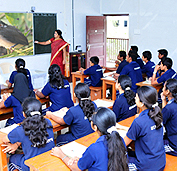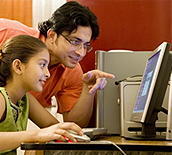There is a need for tuitions to come up to the same level of digital experience as schools. We get the class room digital board to your personal desktop. Understand your learning style, your pace, and personalises and customises teaching for you. Let’s look at the channels through which a child receives education:

School
In traditional schools, the teachers teach with the help of chalk, blackboard and textbooks to an average of 40 students per class. The method of teaching is time-based, and revolves around learning by rote. Information is transferred with the help of the text book. In short, it is a passive learning method.
Based on the evolving trends in learning and teaching methodologies in the 21st century, the school-based education system is also evolving. Teachers are getting trained in pedagogical techniques, and educational tools and technologies (ETT) such as rich digital content, virtual and real-time practice labs, hands-on activities, projects, and simulations. A good 21st century school may promise your child all of these.
However, for the most part, the guidance provided at schools is geared towards getting students to clear the exams with good marks. Schools run on tight schedules, struggling to complete the syllabus on time. Opportunities to ask questions, especially where the slow or even the average learner is concerned, often become a casualty of this schedule. The pace is suited to the bright child.

Home Tuition
Home tuitions are a channel used to fill this gap. The child gets personalised attention. However, there are some limitations to home tuitions:
Thus, through home tuitions, a student gets information, but not the skills that he or she can build through learning in a group.
Additionally, home tuitions are quite expensive.

Coaching Centre
Coaching centres attempt to fill the gap left by schools as well as home tuitions.
However, ‘After School’ coaching and tutorial centres mostly follow the traditional methods of teaching - lecturing their students - and have the same assessment systems in place. For example, in majority of classrooms and after-school centres Even today, there is crowd of at least 20 students in class with 1 tutor; the chalk and the blackboard are still the primary teaching aids, and the method of learning is still rote-based. Thus, we again witness the same mode of information transfer to fill a vessel.
NLCs attempt to fill all of these gaps and to offer an ideal after-school programme for the child. A programme that offers personalised attention, imparts training for the next generation skills, and helps improve the child’s scores.